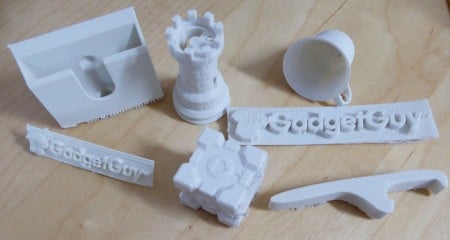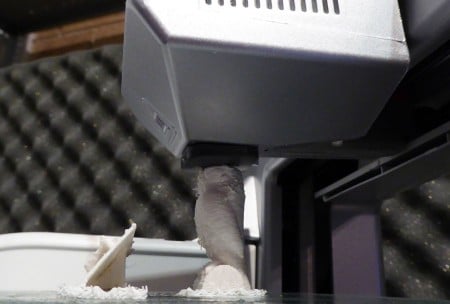And then there’s the “Mr. Fix-it” type scenarios, of which there are quite a few.
If you end up breaking the door off a camera (which an ex-girlfriend did to one owned by this reviewer), you could print a new one and hook it back on.
Need a new door knob? Print one.
How about hooks for your home, or even an iPhone wall mount? All printable.

The downside to this is knowing that someone is going to have to make 3D models of these, and the skills needed for making those digital 3D models aren’t included with the printer.
And frankly, there is a steep learning curve for anyone keen to try their hands at 3D modelling. It’s not like opening up Paint and spraying a canvas with a digital paintbrush. Modelling takes time, and is closer to working out of clay than just taking a photo and making the 3D version of that appear.
You could start with the free 3D modelling application Blender, but there are loads out there, with Lightwave, 3D Studio Max, Maya, and Modo ranking among this journalist’s favourite to use. Courses can be found online, and there are loads of tutorials.
Plus 3D Systems (the maker of the Cube printer) has its own software that you can use to make models, though it is optional and does cost extra.
But if you’re lazy and/or don’t care to dabble in 3D model making, there are other things you can try, helping you get around the learning curve that is “3D vs 2D.”
One of these is Tinkercad, an online browser-based 3D creation tool that can let you use simple tools to create some complicated objects, with the end result being a file that can be printed by the Cube 3D printer.
Another option is to scan in an object, person, or animal using a 3D scanner. These are harder to come by, but Autodesk has helped make the process easier with 123D Catch, an iPhone app that works together with a Windows software counterpart to make 3D models from multiple photos. Our experience with this has been hit and miss, but if you nail the photos from all angles, you might get lucky.
The easiest option, though, is to get the 3D files from a repository, and there are a few of these around.
Our favourite — by far — is Thingiverse, a website connected with another 3D printer manufactured by MakerBot.
Thingiverse is more or less what the name implies, and represents a universe of “things” you can download and print. They could be ornaments, smartphone cases, watch holders, bracelets, beads; anything, really, and there are a ton of 3D files you can look through and start playing with.

On the down side…
3D printing is a new concept, and really, owning a 3D printer puts you at the forefront of what will likely be the next technological revolution. No longer will you have to wait to buy that iPhone case, and you can even prototype your own furniture or product concepts.
But it is a new technology, and as a result it does come with its own set of issues.
The first one is the setup, which is just plain awful. We’ve already been through it, and have dedicated a section on it in the first part of this review, but it’s just abysmal.
Be patient with the Cube and you’ll get far, provided you read the manual. Assume you know it all and that it’s like every other computer peripheral you’ve ever used and, well, let’s just say you may find the urge to throw the thing out the window.
3D Systems hasn’t made it any easier by throwing a USB port on the back of the printer, because while it’s a wireless only device, it still has this old school USB port, which is apparently there for delivering firmware updates, but can’t be used to hook the printer up to your computer.
Call us crazy, but printers should generally offer both forms of connection — wired and wireless — and if your wireless option is buggy, the USB port should do more than let you deliver updates.
When you do get the Cube 3D printer working, you’ll find that it should sit somewhere lonely where people won’t be bothered by the annoying sounds that it makes.
We’re not kidding about this, because this is one noisy device.
If you can imagine robot clowns singing at the top of their lungs for at least an hour non-stop — and depending on the size of the model, longer — that’s basically what the Cube 3D printer sounds like. If you think it’ll be relatively silent like other paper printers out there, well, you’re mistaken. Very mistaken.
Maintenance is also something that is required by the printer, and not the sort that normally exists on paper-based ones, like paper jams and ink head cleaning. We’re talking manual maintenance, and some of it can take time.
For instance, if your prints don’t align properly on the pad, you need to make sure everything is level, which is a manual process involving pressing a few buttons and making sure the Cube printer has a firm grip on a piece of paper.
Your melted plastic can also get stuck in the nozzle, which requires you to pick it out using pliers.
And before you print, you need to lay down a level of clear glue on the printing pad: too much glue and it doesn’t work properly, and not enough glue and the plastic is next to impossible to scrape off without scrubbing in hot water (as seen above).
As we said, it’s a new technology, but just be aware of the maintenance issues before you go in, because it’s not like the occasional paper jam, as this is a more hands-on product.
Conclusion
While this is the first printer for consumers to showcase the future of printing, it’s clear that Cube’s printer isn’t really ready for regular everyday mum and dad. In fact, the setup issues and steep learning curve required for 3D modelling means that all you’ll be able to regularly do is download and print models, rather than build them yourself.
That’s not a bad thing, mind you, and if you’ve been itching to learn Lightwave, Blender, 3DS Max, or Maya, owning a 3D printer could just be the kick in the pants you were looking for, since you’ll be able to print those ideas into real physical items that occupy more space than just the z axis on your computer’s screen.
Even if you’re not interested in learning 3D modelling, the availability of 3D models can make this a really interesting product to own, especially if you’re into making things around the house. Hooks, accessories — hell, you can even spend a couple of days printing your own custom chess set.
We have no doubt that in a few years, physical printing will be a norm, and a much more stabilised and better developed norm. Right now, though, it’s the sort of early adoption project that not everyone needs, but if you’re curious, it does bring the future to your desktop now.








































Big regrets buying this product. The appearance of the product gives the impression that it is easy to use, but overall it is not a product ready for market. I spent so many hours replacing parts and jury rigging the machine to justify the investment I made, but to no avail. Had to replace the print head because it would not feed filament. But no better luck using the replacement head in that it is nearly impossible to get plastic to flow. 3DSystems employs a chip to ensure you use their overpriced filament cartridges. But the prongs on the machine are very fragile – meant for cell phone battery not contact with to a big heavy filament cartridge – you are stuck with an unusable printer. I had to take the whole unit apart and start soldering new contacts on to get the unit to recognize the cassette. Finally 3D Systems requires you to use their special Cubestick rather than using a heated platform that all other printers employ. Too much or too little glue won’t work and if the glue dries while you struggle to load the filament, the printed part will move and you end up with a birdsnest of tangled filament instead of a printed part. Buyer beware.